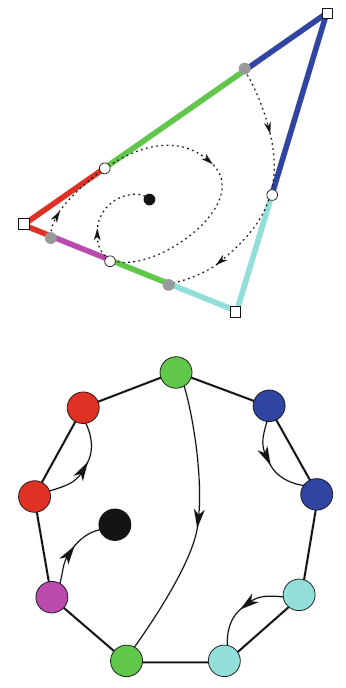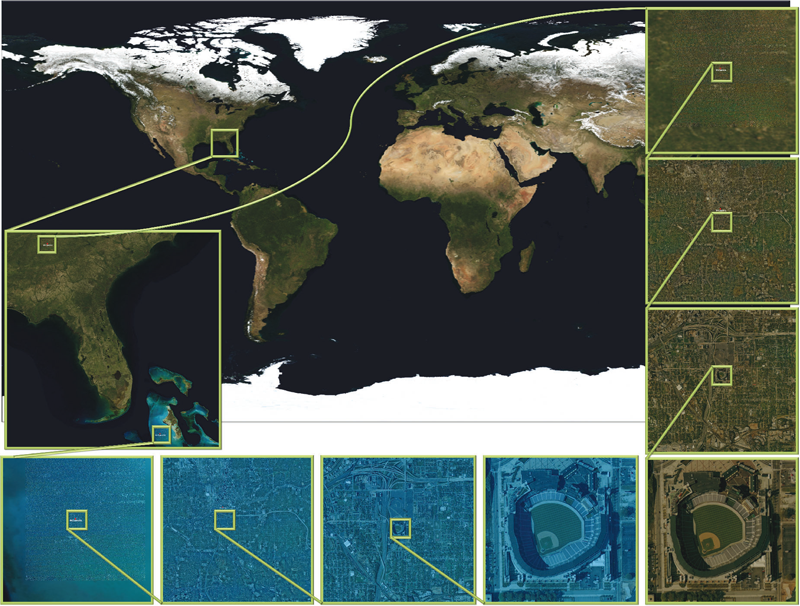SCI Publications
2011
H. Bhatia, S. Jadhav, P.-T. Bremer, G. Chen, J.A. Levine, L.G. Nonato, V. Pascucci.
“Flow Visualization with Quantified Spatial and Temporal Errors using Edge Maps,” In IEEE Transactions on Visualization and Computer Graphics (TVCG), Vol. 18, No. 9, IEEE Society, pp. 1383--1396. 2011.
DOI: 10.1109/TVCG.2011.265
S. Jadhav, H. Bhatia, P.-T. Bremer, J.A. Levine, L.G. Nonato, V. Pascucci.
“Consistent Approximation of Local Flow Behavior for 2D Vector Fields,” In Mathematics and Visualization, Springer, pp. 141--159. Nov, 2011.
DOI: 10.1007/978-3-642-23175-9 10

Typically, vector fields are stored as a set of sample vectors at discrete locations. Vector values at unsampled points are defined by interpolating some subset of the known sample values. In this work, we consider two-dimensional domains represented as triangular meshes with samples at all vertices, and vector values on the interior of each triangle are computed by piecewise linear interpolation.
Many of the commonly used techniques for studying properties of the vector field require integration techniques that are prone to inconsistent results. Analysis based on such inconsistent results may lead to incorrect conclusions about the data. For example, vector field visualization techniques integrate the paths of massless particles (streamlines) in the flow or advect a texture using line integral convolution (LIC). Techniques like computation of the topological skeleton of a vector field, require integrating separatrices, which are streamlines that asymptotically bound regions where the flow behaves differently. Since these integrations may lead to compound numerical errors, the computed streamlines may intersect, violating some of their fundamental properties such as being pairwise disjoint. Detecting these computational artifacts to allow further analysis to proceed normally remains a significant challenge.
S. Philip, B. Summa, P.-T. Bremer, and V. Pascucci.
“Parallel Gradient Domain Processing of Massive Images,” In Proceedings of the 2011 Eurographics Symposium on Parallel Graphics and Visualization, pp. 11--19. 2011.

S. Philip, B. Summa, P-T Bremer, V. Pascucci.
“Hybrid CPU-GPU Solver for Gradient Domain Processing of Massive Images,” In Proceedings of 2011 International Conference on Parallel and Distributed Systems (ICPADS), pp. 244--251. 2011.

M. Schulz, J.A. Levine, P.-T. Bremer, T. Gamblin, V. Pascucci.
“Interpreting Performance Data Across Intuitive Domains,” In International Conference on Parallel Processing, Taipei, Taiwan, IEEE, pp. 206--215. 2011.
DOI: 10.1109/ICPP.2011.60
B. Summa, G. Scorzelli, M. Jiang, P.-T. Bremer, V. Pascucci.
“Interactive Editing of Massive Imagery Made Simple: Turning Atlanta into Atlantis,” In ACM Transactions on Graphics, Vol. 30, No. 2, pp. 7:1--7:13. April, 2011.
DOI: 10.1145/1944846.1944847

This article presents a simple framework for progressive processing of high-resolution images with minimal resources. We demonstrate this framework's effectiveness by implementing an adaptive, multi-resolution solver for gradient-based image processing that, for the first time, is capable of handling gigapixel imagery in real time. With our system, artists can use commodity hardware to interactively edit massive imagery and apply complex operators, such as seamless cloning, panorama stitching, and tone mapping.
We introduce a progressive Poisson solver that processes images in a purely coarse-to-fine manner, providing near instantaneous global approximations for interactive display (see Figure 1). We also allow for data-driven adaptive refinements to locally emulate the effects of a global solution. These techniques, combined with a fast, cache-friendly data access mechanism, allow the user to interactively explore and edit massive imagery, with the illusion of having a full solution at hand. In particular, we demonstrate the interactive modification of gigapixel panoramas that previously required extensive offline processing. Even with massive satellite images surpassing a hundred gigapixels in size, we enable repeated interactive editing in a dynamically changing environment. Images at these scales are significantly beyond the purview of previous methods yet are processed interactively using our techniques. Finally our system provides a robust and scalable out-of-core solver that consistently offers high-quality solutions while maintaining strict control over system resources.
D. Thompson, J.A. Levine, J.C. Bennett, P.-T. Bremer, A. Gyulassy, V. Pascucci, P.P. Pebay.
“Analysis of Large-Scale Scalar Data Using Hixels,” In Proceedings of the 2011 IEEE Symposium on Large-Scale Data Analysis and Visualization (LDAV), Providence, RI, pp. 23--30. 2011.
DOI: 10.1109/LDAV.2011.6092313
S. Williams, M. Petersen, P.-T. Bremer, M. Hecht, V. Pascucci, J. Ahrens, M. Hlawitschka, B. Hamann.
“Adaptive Extraction and Quantification of Geophysical Vortices,” In IEEE Transactions on Visualization and Computer Graphics, Proceedings of the 2011 IEEE Visualization Conference, Vol. 17, No. 12, pp. 2088--2095. 2011.
2010
S. Gerber, P.-T. Bremer, V. Pascucci, R.T. Whitaker.
“Visual Exploration of High Dimensional Scalar Functions,” In IEEE Transactions on Visualization and Computer Graphics, IEEE Transactions on Visualization and Computer Graphics, Vol. 16, No. 6, IEEE, pp. 1271--1280. Nov, 2010.
DOI: 10.1109/TVCG.2010.213
PubMed ID: 20975167
PubMed Central ID: PMC3099238
S. Jadhav, H. Bhatia, P.-T. Bremer, J.A. Levine, L.G. Nonato, V. Pascucci.
“Consistent Approximation of Local Flow Behavior for 2D Vector Fields using Edge Maps,” SCI Technical Report, No. UUSCI-2010-004, SCI Institute, University of Utah, 2010.
2009
E.W. Bethel, C.R. Johnson, S. Ahern, J. Bell, P.-T. Bremer, H. Childs, E. Cormier-Michel, M. Day, E. Deines, P.T. Fogal, C. Garth, C.G.R. Geddes, H. Hagen, B. Hamann, C.D. Hansen, J. Jacobsen, K.I. Joy, J. Krüger, J. Meredith, P. Messmer, G. Ostrouchov, V. Pascucci, K. Potter, Prabhat, D. Pugmire, O. Rubel, A.R. Sanderson, C.T. Silva, D. Ushizima, G.H. Weber, B. Whitlock, K. Wu.
“Occam's Razor and Petascale Visual Data Analysis,” In Journal of Physics: Conference Series, Journal of Physics: Conference Series, Vol. 180, No. 012084, pp. (published online). 2009.
DOI: 10.1088/1742-6596/180/1/012084
One of the central challenges facing visualization research is how to effectively enable knowledge discovery. An effective approach will likely combine application architectures that are capable of running on today's largest platforms to address the challenges posed by large data with visual data analysis techniques that help find, represent, and effectively convey scientifically interesting features and phenomena.
K. Potter, A. Wilson, P.-T. Bremer, D. Williams, C. Doutriaux, V. Pascucci, C.R. Johhson.
“Visualization of Uncertainty and Ensemble Data: Exploration of Climate Modeling and Weather Forecast Data with Integrated ViSUS-CDAT Systems,” In J. Phys.: Conf. Ser., Vol. 180, No. 012089, IOP Publishing, pp. 012089. July, 2009.
DOI: 10.1088/1742-6596/180/1/012089
K. Potter, A. Wilson, P.-T. Bremer, D. Williams, C. Doutriaux, V. Pascucci, C.R. Johnson.
“Ensemble-Vis: A Framework for the Statistical Visualization of Ensemble Data,” In Proceedings of the 2009 IEEE International Conference on Data Mining Workshops, pp. 233--240. 2009.
2007
E.W. Bethel, C.R. Johnson, C. Aragon, Prabhat, O. Rübel, G. Weber, V. Pascucci, H. Childs, P.-T. Bremer, B. Whitlock, S. Ahern, J. Meredith, G. Ostrouchov, K. Joy, B. Hamann, C. Garth, M. Cole, C.D. Hansen, S.G. Parker, A.R. Sanderson, C.T. Silva, X. Tricoche.
“DOE's SciDAC Visualization and Analytics Center for Enabling Technologies - Strategy for Petascale Visual Data Analysis Success,” In CTWatch Quarterly, Vol. 3, No. 4, 2007.
P.-T. Bremer, E.M. Bringa, M.A. Duchaineau, A. Gyulassy, D. Laney, A. Mascarenhas, V. Pascucci.
“Topological Feature Extraction and Tracking,” In Proceedings of SciDAC 2007 -- Scientific Discovery Through Advanced Computing, Boston, MA, USA, Vol. 78, Journal of Physics Conference Series, pp. 012032 (5pp). June, 2007.
P.-T. Bremer, V. Pascucci.
“A Practical Approach to Two-Dimensional Scalar Topology,” In Mathematics and Visualization, Springer Verlag, pp. 151--169. 2007.
ISBN: Online ISBN 978-3-540-70823-0 Series Title Mathematics and Visualization Series ISSN 1
DOI: 10.1007/978-3-540-70823-0_11
Computing and analyzing the topology of scalar fields has proven to be a powerful tool in a wide variety of applications. In recent years the field has evolved from computing contour trees of two-dimensional functions to Reeb graphs of general two-manifolds, analyzing the topology of time-dependent volumes, and finally to creating Morse-Smale complexes of two and three dimensional functions. However, apart from theoretical advances practical applications depend on the development of robust and easy to implement algorithms. The progression from initial to practical algorithms is evident, for example, in the contour tree computation where the latest algorithms consist of no more than a couple of dozens lines of pseudo-code. In this paper we describe a similarly simple approach to compute progressive Morse-Smale complexes of functions over two-manifolds. We discuss compact and transparent data-structures used to compute and store Morse-Smale complexes and demonstrate how they can be used to implement interactive topology based simplification. In particular, we show how special cases arising, for example, from manifolds with boundaries or highly quantized functions are handled effectively. Overall the new algorithm is easier to implement and more efficient both run-time and storage wise than previous approaches by avoiding to refine a given triangulation.
D. Laney, P.-T. Bremer, A. Mascarenhas, P. Miller, V. Pascucci.
“Understanding the Structure of the Turbulent Mixing Layer in Hydrodynamic Instabilities,” In IEEE Transactions on Visualization and Computer Graphics, Vol. 13, No. 1, pp. 1053--1060. January, 2007.
V. Pascucci, G. Scorzelli, P.-T. Bremer, A. Mascarenhas.
“Robust On-line Computation of Reeb Graphs: Simplicity and Speed,” In ACM Transactions on Graphics: ACM SIGGRAPH 2007 Papers, ACM Press, New York, NY, USA pp. 1057--1066. 2007.
G.H. Weber, P.-T. Bremer, V. Pascucci.
“Topological Landscapes: A Terrain Metaphor for Scientific Data,” In IEEE Transactions on Visualization and Computer Graphics, Note: (presented at IEEE VIS 2007), 2007.
2006
P.-T. Bremer, W. Cabot, A. Cook, D. Laney, A. Mascarenhas, P. Miller, V. Pascucci.
“Understanding the Structure of the Turbulent Mixing Layer in Hydrodynamic Instabilities,” In Proceedings of SciDAC 2006 -- Scientific Discovery Through Advanced Computing, Denver, CO, USA, Vol. 46, Journal of Physics Conference Series, pp. 556--560. June, 2006.
Page 4 of 5
